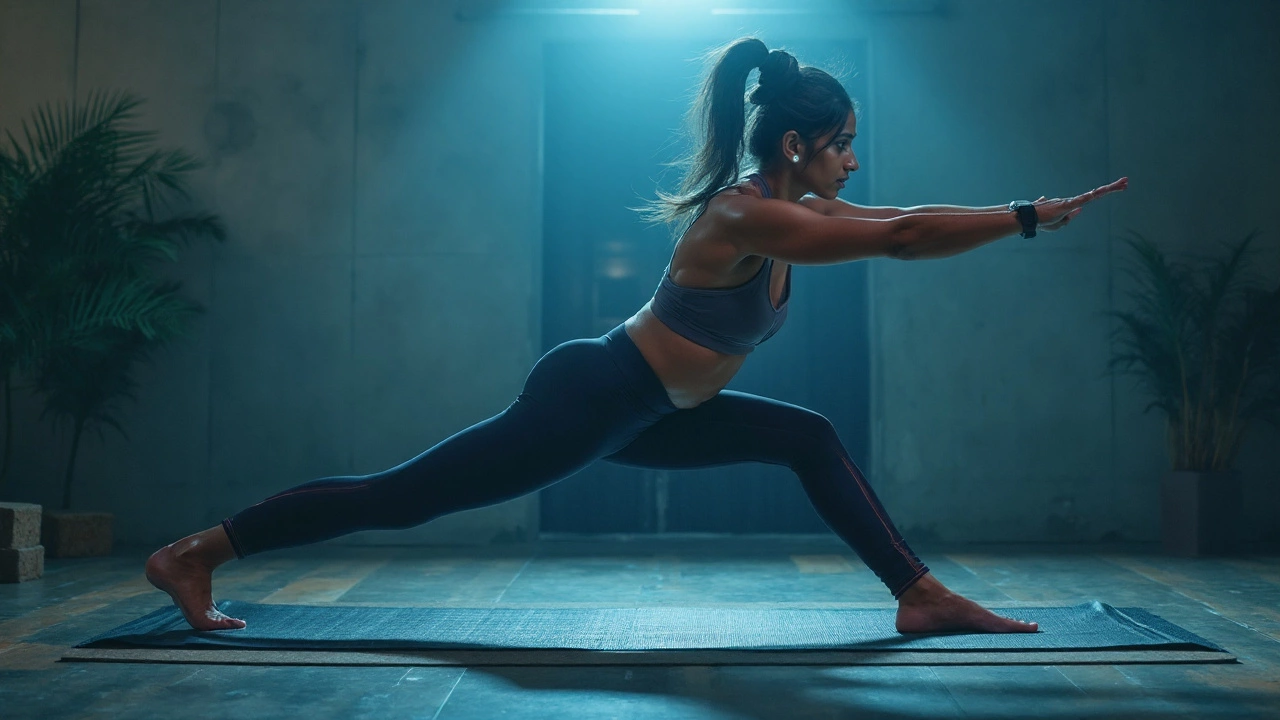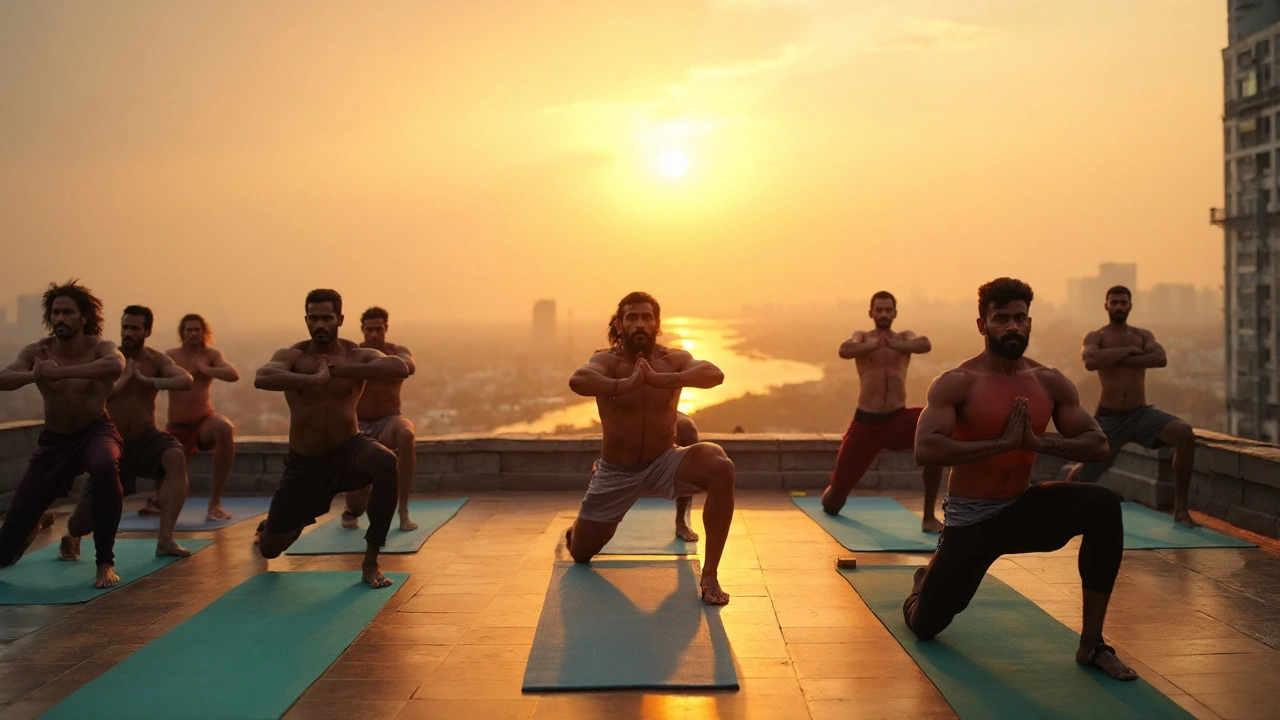You want a simple answer: can you get toned from just doing yoga? Yes-if you choose the right classes, train with enough effort, and give it time. You’ll build visible muscle definition and drop body fat without touching a barbell. But not every yoga style will do the trick, and your food, sleep, and consistency matter more than the brand of mat under your feet. I practice in windy Wellington with a nosy cat named Whiskers who treats my chaturangas like a spectator sport-so trust me, I’ve tested what works when real life shows up.
The Quick Answer: Can You Get Toned From Just Doing Yoga?
Short version first, because you want clarity:
- Yes, you can get toned with yoga alone-if sessions are challenging, consistent, and progressive.
- Power, Ashtanga, and strong Vinyasa styles drive the most muscular change; gentle or restorative yoga supports recovery.
- "Toned" means enough muscle + low enough body fat to see it. Yoga builds muscle and burns calories; your diet reveals definition.
- Train hard 3-5 days a week for 8-12 weeks to notice definition; 12-24 weeks for a clear change in photos.
- Prioritize push/pull/leg patterns in yoga form: chaturanga/planks (push), pulls via isometrics and arm balances, lunges/chair/warriors (legs).
If you just do casual flows, you’ll get flexible and feel great, but your body won’t change much. Make your yoga sessions feel like strength workouts, and it will.
How Toning Works (And What Kind of Yoga Delivers It)
Let’s get on the same page. “Tone” is visible muscle definition. You need two things:
- Muscle: built by mechanical tension and sufficient effort.
- Lower body fat: revealed by smart eating and enough weekly activity.
Yoga can do both-but mainly if you choose strong practices that mimic resistance training. Think: slow negatives into chaturanga, long holds in chair pose, repeated transitions to fatigue, and tough balances that load your hips and shoulders.
What the science says:
"Adults should perform muscle-strengthening activities of moderate or greater intensity involving all major muscle groups on two or more days a week." - American College of Sports Medicine (ACSM, 2021)
That’s your green light. Strong yoga can meet this if you push to a tough effort. And this matters, too:
"Both low-load and high-load resistance training can produce comparable hypertrophy when sets are performed with a high level of effort." - Brad Schoenfeld, PhD (2017)
Translation: you don’t have to lift heavy. You do have to work hard. Long holds and higher reps in yoga can grow muscle if you approach near-failure safely. That’s your lever.
Which styles deliver?
- Power Vinyasa / Hot Power: vigorous flows, lots of push-ups, squat patterns, and holds. Great for upper and lower body definition.
- Ashtanga / Rocket: structured sequences with repeated strength elements and progressive binds. Excellent for arms, back, and core.
- Strong Vinyasa with targeted blocks: flows + strength “islands” (e.g., 60-90-second chair holds, crow attempts, plank complexes).
- Yin / Restorative: not for toning by themselves, but valuable for recovery and mobility so you can train harder tomorrow.
How long until you see change?
- 2-4 weeks: better mind-muscle connection, less wobble in balances, stronger planks.
- 6-8 weeks: noticeable firmness in arms, thighs, and core; pants fit different.
- 12+ weeks: photos show definition, especially around shoulders, back, and quads.
One more reality check: if you’re already very strong from weights, yoga alone may not add a lot more muscle, but it can maintain it and improve definition if your diet leans up. If you’re newer to strength, yoga can be a full engine for body change.

A Step-by-Step Plan to Get Toned With Yoga Only
Here’s the nuts-and-bolts plan I recommend, refined over years of teaching, practicing, and trial runs between rain bursts in Wellington.
Step 1: Pick your weekly cadence.
- Minimum effective: 3 strong sessions/week (45-60 minutes).
- Great results: 4 strong sessions + 1 recovery session.
- Busy weeks: 2 strong sessions + 2 short 20-minute power blocks.
Step 2: Structure each session for strength.
- Warm-up (5-8 min): cat-cow, sun salutations A/B, hip openers.
- Strength block 1 (10-15 min): push pattern focus (plank variations, chaturanga negatives, side plank).
- Strength block 2 (10-15 min): squat/lunge focus (chair holds, warrior sequences, crescent lunge pulses).
- Strength block 3 (8-12 min): hinge/glute + core (bridge holds, dolphin, boat, locust).
- Flow finisher (5-10 min): brisk vinyasa with step-backs and controlled lowers to spike heart rate.
- Cool down (5-8 min): hamstrings, hip flexors, thoracic rotation, 2-3 quiet minutes.
Step 3: Use progressive overload, yoga-style.
- Increase time-under-tension: extend holds from 20-30 seconds to 45-60 seconds.
- Slow your lowers: 3-5 second eccentrics into chaturanga and chair.
- Add reps: more vinyasa transitions, more controlled step-backs/step-throughs.
- Harder variations: knees-off side plank, pistol-prep chair, crow, flying lunge hops.
- Reduce rest: shorten transitions while keeping form sharp.
Step 4: Track effort. Use an honest 1-10 scale.
- Strength blocks should feel like 7-9/10 by the last 20% of the set. If you could chat easily, it’s too easy.
- Finish reps with form intact; stop one rep before you’d lose posture or breath control.
Step 5: Commit to a 6-week plan.
Week-by-week guide:
- Week 1: 3 sessions. Aim for 20-30 second holds; 8-10 controlled vinyasa reps per block.
- Week 2: 3-4 sessions. Add 1-2 reps per block; hold chair and forearm plank 5-10 seconds longer.
- Week 3: 4 sessions. Introduce eccentric focus (3-5 sec lowers) into chaturanga and chair.
- Week 4: 4-5 sessions. Add one advanced option (crow practice, dolphin push-ups) and a brisk finisher.
- Week 5: 4 sessions. Slight deload-remove one set per block but keep intensity; push range of motion.
- Week 6: 4-5 sessions. Peak week-longest holds (45-60 sec), most controlled transitions, one balance focus per session.
Sample weekly schedule (swap days to fit your life):
- Monday: Power Vinyasa (upper-body push focus)
- Tuesday: Strong Vinyasa (legs + glutes)
- Thursday: Ashtanga-based or Rocket-inspired flow (full-body)
- Saturday: Power Vinyasa + core finisher
- Optional: Wednesday or Sunday yin/restorative (recovery)
Conditioning add-ons if you want faster fat loss (still yoga-only):
- Salutation ladders: 10-15 minute EMOM (every minute on the minute) of 4-6 sun salutations A at a steady pace.
- Flow sprints: 4 rounds of 90 seconds of brisk vinyasa + 60 seconds slow nasal-breathing flow.
Poses, Flows, and Progressions That Build Visible Muscle
Here’s the targeted work. Think “push, legs, core, back” and choose progressions that make you earn your breath.
Upper-body push and stability
- Plank to Chaturanga: 3-5 sets of 3-6 slow lowers (3-5 seconds), optional knee tap pause.
- Side Plank (Vasisthasana): 3 sets of 20-45 seconds/side; progress to star plank (top leg lift).
- Dolphin Push-ups: 3 sets of 6-10 reps for shoulders and upper back.
Legs and glutes
- Chair Pose (Utkatasana) Holds: 3-4 sets of 30-60 seconds; keep knees tracking toes; micro-move hips back on exhales.
- Crescent Lunge Pulses: 3 sets of 10-15 slow pulses/side; finish with a 20-second static hold.
- Warrior II to Skandasana Flow: 3 sets of 5-8 reps each direction; slow, deep, knee-friendly range.
Hinge and posterior chain
- Locust Variations (Salabhasana): 3 sets of 10-15 reps; pause at the top for 2 seconds.
- Bridge Holds: 3 sets of 30-45 seconds; progress to single-leg bridges for 10-12 reps/side.
- Half Splits to Lizard: move slow, loading hamstrings and hip flexors through range.
Core and anti-rotation
- Boat Pose (Navasana): 3 sets of 20-40 seconds; rock into low boat and back without losing spine shape.
- Forearm Plank with Reach: 3 sets of 8-12 reaches/side; no hip sway.
- Twisting Chair: 3 sets of 20-30 seconds/side; ribs stay stacked over hips.
Arm balances and advanced options (optional but potent)
- Crow (Bakasana): 3-5 attempts of 10-20 seconds; focus on knee-to-tricep clamp and gaze forward.
- Flying Lunge Hops: 3 sets of 6-10 hops/side; land soft, knees tracking.
- Handstand Prep at Wall: 3-5 kick-ups for 10-15 seconds; shoulder strength and confidence builder.
Technique guardrails (don’t skip):
- Wrist care: warm with circles, palm pulses; stack shoulders over wrists; spread fingers.
- Shoulders: keep elbows close in chaturanga; stop before low-back sag.
- Knees: in chair and lunges, sit back, weight mid-foot to heel; track knees over second toe.
- Breathing: nasal inhale to brace; slow mouth or nose exhale through hard parts to stay braced.
How to quantify effort without weights
- Hold time: aim for 30-60 seconds where the last 5-10 seconds feel shaky but controlled.
- Rep ranges: 8-15 slow reps per side; last 2 reps should burn without form collapse.
- Density: complete a block faster with the same quality = you got fitter.

Nutrition, Recovery, and Realistic Expectations + Mini‑FAQ
You can out-yoga a bad plan, but not a bad diet. To get leaner and show muscle, keep it simple:
Nutrition rules of thumb
- Protein: 1.6-2.2 g/kg body weight daily. Hit protein at each meal (eggs, Greek yogurt, tofu, tempeh, fish, legumes).
- Calorie balance: for fat loss, a modest 300-500 kcal/day deficit; for recomposition at maintenance, keep protein high and train hard.
- Fiber: 25-35 g/day from plants. It helps appetite and gut health.
- Carbs around training: a banana or toast with peanut butter 60-90 minutes before a hard flow; a balanced meal after.
- Hydration: clear to pale yellow urine. Add a pinch of salt with long hot classes.
Recovery that actually moves the needle
- Sleep: 7-9 hours. Non-negotiable if you want visible abs to say hello.
- Walks: 6-10k steps/day, especially on rest days. Easy fat-burning without stress.
- Mobility/Yin: 1 session/week to keep joints happy and push usable range of motion.
What if progress stalls?
- No strength progress: lengthen holds or add one harder variation; film a set to check form leaks.
- No fat loss: tighten liquid calories and late-night snacks; add a 10-15 min flow finisher twice a week.
- Low energy: eat a small carb + protein snack pre-class; check sleep debt.
Mini‑FAQ
- Do I need weights to get toned? No. Yoga can build muscle and definition if you train near your limit with progression. Weights are a faster lever for advanced lifters, but not required.
- How long will it take? Expect 8-12 weeks for visible changes if you train 3-5 days/week and eat for your goal.
- Which classes should I book? Power, strong Vinyasa, Ashtanga, or Rocket. If the class description says “gentle” or “restorative,” treat it as recovery.
- Is hot yoga better for fat loss? It can feel harder, but most of the scale drop is sweat. The driver is effort and consistency, not room temperature.
- Can I tone at 40, 50, 60+? Yes. Muscle responds to effort at any age. Warm longer, progress slower, protect joints, keep protein higher.
- What about my wrists? Strengthen with palm leans, fist planks, and forearm variations; spread load, stack joints, and build time slowly.
- Will yoga make me bulky? Unlikely. Yoga tends to build lean, dense muscle with lots of bodyweight repetitions and holds.
- Can I recomposition (lose fat, gain muscle) with yoga? Beginners and returners often can if protein is high and sleep is on point.
Quick checklists
- Weekly: 3-5 strong sessions + 1 recovery.
- Per session: 3 strength blocks (push, legs, core/back) + finisher.
- Progression: longer holds, slower eccentrics, harder variations, tighter rest.
- Nutrition: protein at every meal, plants, smart carbs around training.
- Recovery: 7-9 hours sleep, daily steps, one yin session.
If you want a simple yes/no: yes, you can get toned from just doing yoga. The catch is effort and progression. If you treat your mat like a gym-count holds, chase clean reps, breathe with intent-you’ll see your shoulders round out, your legs firm up, and your core pop. On chilly Wellington mornings, I chase that first steady breath while Whiskers judges my form from the heater. It all counts. And it works.
Evidence notes
- ACSM’s position stand supports strength work 2+ days/week for health and muscular benefits; well-structured yoga fits.
- Research led by Schoenfeld and others shows low-load, high-effort training can build muscle comparably to heavier loads when taken near failure-exactly how strong yoga functions.
Next steps by persona
- Beginner who’s stiff: start with 3 days/week strong but short sessions (30-40 minutes), add one yin class; focus on chair, planks, bridges, and warrior flows.
- Time‑crunched parent: two 25‑minute home flows midweek + one 60‑minute power class on the weekend; keep a 10‑minute salutation ladder in your back pocket.
- Runner/cyclist: two strong yoga days for legs and core + one recovery yin; watch hamstring loading and balance it with posterior chain work (bridge, locust).
- Desk worker with cranky wrists: build with forearm planks, dolphin, and knuckle planks; add wrist prep daily for 3 minutes.
One last nudge: track something. Hold times, reps, how many clean chaturanga lowers you own. Progress is proof. And proof is momentum.
TL;DR checklist to pin on your fridge:
- Pick strong classes (Power, Ashtanga, Rocket).
- Train 3-5 days/week; last reps/seconds should feel like a 7-9/10 effort.
- Push, legs, core every session; finish with a brisk flow.
- Eat protein at each meal; sleep 7-9 hours.
- Give it 8-12 weeks and take photos. The mirror lies; the camera doesn’t.
If you remember nothing else, remember this: consistent, hard, progressive yoga is yoga for toning. Do that, and your mat becomes the only equipment you need.





